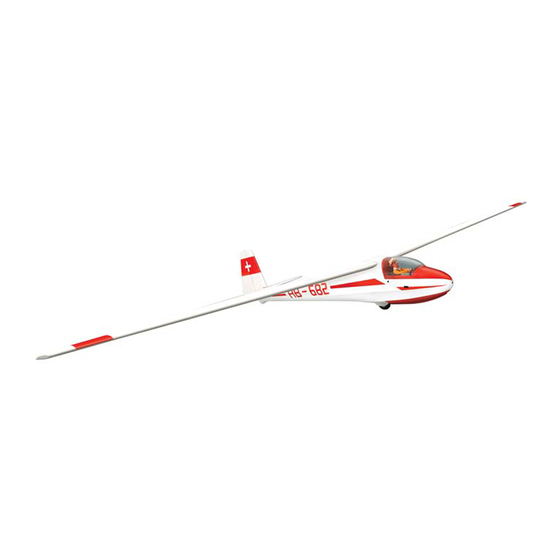
Subscribe to Our Youtube Channel
Summary of Contents for Phoenix Model K8B
- Page 1 Instruction Manual Wingspan : 3500mm (137.8 inch) Length : 1650mm (64.96 inch) Weight : 3700gr Radio : 5 servo standard / 6 channel...
-
Page 2: Kit Contents
KIT CONTENTS: We have organized the parts as they come out of the box for better identification during assembly. We recommend that you regroup the parts in the same manner. This will ensure you have all of parts required before you begin assembly. KIT CONTENTS AILERON CONTROL SYSTEM fuselage WHEEL ASSEMBLY... -
Page 3: Tools And Supplies Needed
This will assure proper assembly. The K8B is hand made from natural materials, every plane is unique and minor adjustments may have to be made. However, you should find the fit superior CUT THE COVERING and assembly simple. -
Page 4: Installing The Aileron Servos
5. Apply six drops of thin CA to the top and bottom 4. Using the thread as a guide and using masking of each hinge. Do not use CA accelerator. After tape, tape the servo lead to the end of the the CA has fully hardened, test the hinges by thread: carefully pull the thread out. -
Page 5: Installing The Control Horns
INSTALLING THE CONTROL HORNS 3. Locate one nylon servo arm, and using wire cutters, remove all but one of the arms. Using a 2mm drill bit, enlarge the third hole out from the 1. One aileron control horn in positioned on each aileron. -
Page 6: Installing The Horizontal Stabilizer
4. Secure the horizontal onto the fuselage. INSTALLING THE HORIZONTAL STABILIZER 1. Remove the covering. INSTALLING THE elevator Repeat step #1 - #5 from installing the aileron to install the elevator. Glue the hinges by C.A glue 2. Attach the wing to the fuselage as picture. INSTALLING THE RUDDER 1. - Page 7 3. Insert the vertical stabilizer into the fuselage. INSTALLING THE main landing gear 4. Remove the covering from the fuselage. 1. The full set wheel. 2. Secure the collars. 5. Secure the vertical stabilizer into the fuselage. 3. Glue the wooden plate to the fuselage.
-
Page 8: Installing The Elevator Pushrod
SERVO INSTALLATION INSTALLING THE FUSELAGE SERVOS 1. Install the rubber grommets and brass collets into the elevator, rudder and towing servos. Test fit the servos into the servo tray. Trim the tray if necessary to fit your servos 2. Mount the servos to the tray using the mounting screws provided with your radio system. -
Page 9: Installing The Rudder Pushrod
12. With the elevator halves and elevator servo 6. Drill 3mm holes through the rudder using the centered, carefully place a mark on the elevator control horn as a guide and screw the control pushrod wire where it crosses the hole in the horn in place. -
Page 10: Installing The Switch
INSTALLING THE RECEIVER AND BATTERY 1. Plug the servo leads and the switch lead into the receiver. You may want to plug an aileron extension into the receiver to make plugging in the aileron servo lead easier when you are installing the wing. -
Page 11: Lateral Balance
3. Turn the airplane upside down. Place your Open and close the canopy fingers on the masking tape and carefully lift the plane . 4. If the nose of the plane falls, the plane is nose heavy. To correct this first move the battery pack further back in the fuselage. -
Page 12: Flight Preparation
FLIGHT PREPARATION 10mm 10mm PRE FLIGHT CHECK 1. Completely charge your transmitter and receiver Aileron Control batteries before your first day of flying. 2. Check every bolt and every glue joint in your plane to ensure that everything is tight and well bonded. - Page 13 I/C FLIGHT WARNINGS Always operate in open areas, away Keep all onlookers (especially small from factories, hospitals, schools, THE PROPELLER IS DANGEROUS children and animals) well back from buildings and houses etc. NEVER fly Keep fingers, clothing (ties, shirt the area of operation. This is a flying your aircraft close to people or built sleeves, scarves) or any other loose aircraft, which will cause serious...
- Page 14 I/C FLIGHT GUIDELINES Operate the control sticks on the When ready to fly, first extend the transmitter and check that the control transmitter aerial. surfaces move freely and in the ALWAYS land the model INTO the CORRECT directions. wind, this ensures that the model lands at the slowest possible speed.













Need help?
Do you have a question about the K8B and is the answer not in the manual?
Questions and answers